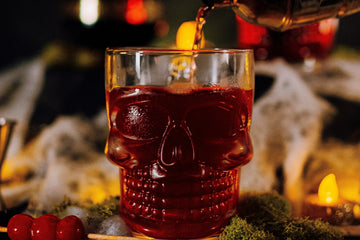What Does Gin Taste Like? (From Professional Distillers)
by William Rusling on Oct 31, 2023

Gin is known for its distinct flavour profile, characterised by the sharp, piney taste of juniper berries. Other botanicals like coriander, citrus peels, and spices are often added, providing a complex blend of earthy, herbal, and floral notes that vary across different brands and styles.
What is Gin Made Out Of?
Gin is a spirit that is distilled from grains, usually barley, rye, or corn, with the dominant flavour being derived from juniper berries. The unique character of gin comes from the botanicals used during the distillation process. Botanicals are plant-derived ingredients which include a wide range of herbs, spices, fruits, flowers, and roots.
The selection of botanicals used can greatly affect the flavour and aroma of the gin. Some commonly used botanicals in gin making include coriander, angelica root, lemon peel, cardamom, cinnamon, and many others. These ingredients are often kept secret by distillers to protect their proprietary blend.
You can learn more about the distilling process.
H2: Understanding the Main Flavour of Gin
The primary taste of gin is a strong, astringent flavour primarily derived from juniper berries, which gives it a pine-like, herbaceous character. However, the taste of gin can vary greatly depending on the botanicals used. Some gins are more citrus-forward, others have a strong spice character, and some are floral and light.
In traditional London dry gins, the juniper flavour is very prominent, accompanied by a spicy, peppery finish from the coriander seeds and a subtle earthiness from the angelica root.
On the other hand, contemporary or 'new wave' gins often downplay the juniper to let other flavours shine through. For example, some gins highlight the citrus elements, resulting in a fresh, zestful flavour, while others may focus on floral notes, leading to a sweeter and more fragrant profile.
When tasting gin, you might also notice a certain warmth or 'burn' – this is due to its high alcohol content, typically between 37.5% and 47% ABV.
Just as with wine or whiskey, there's a vast world of gin flavours to explore, with each distillery offering its own unique take on this versatile spirit. From the traditional juniper-forward London Dry Gin, to the sweeter, more botanical Filey Gin, to the unique profiles of modern craft gins, there's a gin for every palate.
Exploring Different Types of Gin and Their Distinctive Tastes
Gin's diverse flavour profiles result from variations in distilling methods, ingredients, and regional influences. Here, we dive into different types of gin and their characteristic tastes.
London Dry Gin
London Dry Gin is often considered the benchmark for the category. Despite its name, it does not have to be produced in London. This type of gin is defined by its crisp, clean, and robust character, with juniper at the forefront, followed by bright citrus and spice notes. Examples of London Dry Gin include Beefeater, Tanqueray, and Bombay Sapphire.
Old Tom Gin
Old Tom Gin is a sweeter style of gin that bridges the gap between the juniper-forward London Dry Gin and the maltier Dutch Genever. It often has a more rounded flavour profile with a notable sweetness that can either come from added sugar or the use of naturally sweet botanicals. Old Tom is often considered a good choice for classic cocktail recipes like the Tom Collins or Martinez.
Pink Gin
Pink Gin is not merely a colour but represents a delicate and often fruit-forward flavour profile. Usually infused with red and pink fruits such as strawberries, raspberries, or cherries, it also often includes a touch of sweeteners. The result is a gin that is visually appealing and generally more accessible to those new to gin. Pink Gin can be enjoyed in a variety of cocktails, providing a refreshing and often visually stunning twist on traditional gin-based drinks. Whether it's the subtle blush of colour or the gentle fruitiness that appeals, Pink Gin offers a unique and delightful option in the world of gin.
Barrel-Aged Gin
Barrel-Aged Gin, also known as Cask-Aged Gin, is a style that undergoes a period of ageing in barrels. This can result in a gin that carries the flavours of the wood it was aged in, often lending vanilla, caramel, or toasty notes to the gin, much like you might find in a whiskey. The length of ageing can vary, leading to different degrees of flavour complexity and depth.
Contemporary Gin (New Western Gin)
The Contemporary Gin, also referred to as New Western Gin, is a style that often downplays the juniper to allow other flavours to take the stage. These gins are known for their innovative use of botanicals, resulting in a wide variety of flavour profiles. You may find contemporary gins with pronounced notes of cucumber, rose, tea, or any number of other flavours.
Irish Gin
Irish Gin has grown in popularity in recent years, mirroring the global trend towards craft spirits. While there isn't a single defining flavour profile for Irish Gin, a common characteristic is the use of local Irish botanicals. This might include ingredients like Irish moss, shamrock, rowan berries, or even oysters, depending on the distillery. The end result can range from traditional, juniper-heavy gins to gins that are uniquely Irish, reflecting the flavour of the local landscape.
The Unique Essence of Each Gin: No Two Gins are the Same
With such a diverse range of botanicals at their disposal, distillers can create an endless variety of flavour profiles, ensuring no two gins are exactly alike. The combination and proportion of botanicals used in each gin recipe, often referred to as a botanical bill, is typically a closely guarded secret, much like a chef's signature recipe.
The beauty of gin lies in its complexity and versatility. Unlike some other spirits, gin doesn’t have a fixed recipe, which means distillers are free to experiment and innovate. This gives gin its unique ability to represent the personality and vision of the distiller, as well as the local environment where the ingredients are sourced.
From the classic juniper notes of London Dry Gin to the citrus-infused flavours of a Mediterranean gin, from the sweeter, rounded taste of an Old Tom to the bold, experimental flavours of a Contemporary Gin, there's a whole world of tastes, aromas, and experiences waiting to be discovered in every bottle of gin.
And beyond the botanicals and distilling process, other factors also contribute to the uniqueness of each gin. The quality and characteristics of the base spirit, the distillation method, even the water used to dilute the spirit can have a significant impact on the final flavour.
Whether sipped neat, mixed in a cocktail, or paired with tonic water, each gin provides an opportunity to explore a unique flavour landscape. So next time you enjoy a gin, take a moment to savour its complexity, consider the skill and creativity that went into crafting it, and enjoy the journey it takes your palate on. This is the true essence of gin – a spirit that is always evolving, always surprising, and truly one-of-a-kind.
Ingredients That Might Enhance the Taste of Gin
Gin is a versatile spirit that can be sipped on its own or mixed with other ingredients to create a wide variety of cocktails. The flavours of gin can be enhanced by many different ingredients. Here are a few examples:
Soda & Tonic Water
The classic gin and tonic is a beloved combination for a reason. Tonic water, with its slight bitterness, can balance the often piney and herbal notes of gin. Meanwhile, soda water provides a blank canvas to allow the flavour profile of the gin to shine through.
Vermouth
Vermouth is a key component in many gin cocktails, including the martini. Sweet vermouth can complement the botanical flavours in gin, while dry vermouth can bring out gin's crisp, clean qualities.
Lemon & Pineapple Juice
Citrus juices like lemon or lime are often used in gin cocktails, as their acidity can balance the gin's alcohol content. They can also highlight the citrus notes often present in gin. Pineapple juice can add a tropical twist to gin, creating a sweet and tangy combination that pairs particularly well with gins that feature fruit-forward botanicals.
Why Do They Say That No Two Gins Are The Same?
The statement that "no two gins are the same" speaks to the spirit's incredible variety and complexity. The flavour of gin is heavily influenced by its botanicals – the herbs, spices, fruits, and other plant materials that are infused into the spirit during the distillation process.
While all gin contain juniper berries as a key ingredient, beyond that, the selection of botanicals used is up to the distiller. Some gins use just a few botanicals, while others use dozens. Common botanicals include coriander, angelica root, citrus peels, and many others, but there's no limit to what can be used. Some distilleries even forage local plants to create a gin that captures the essence of their specific location.
Each distillery has its own secret recipe, and subtle differences in the proportions of each botanical, the distillation process, and even the quality of the water used can lead to dramatically different flavours. This allows for an almost infinite variety of gin profiles, from floral to spicy, citrusy to earthy, ensuring that every gin offers a unique tasting experience.
Conclusion
The taste of gin is a complex and multifaceted experience that ranges from the traditional juniper-infused flavour to a rich diversity of botanical accents. The variations in gin are broad, influenced by the specific ingredients and distillation techniques employed, giving rise to a spectrum of tastes that can appeal to both the novice and the connoisseur. Whether it's the crisp and piney notes of a classic London Dry Gin or the more nuanced and contemporary expressions found in modern craft gins, there's a world of flavours to explore. Paired with the right mixers or enjoyed in a carefully crafted cocktail, gin offers a unique taste adventure that can be both refreshingly simple and intriguingly complex. For those looking to dive into this multifaceted spirit, there has never been a more exciting time to explore the endless possibilities that gin has to offer.
FAQs
Is gin good for mixing?
Gin is extremely versatile and mixes well with a variety of ingredients, making it a popular base for many cocktails.
Is all gin made with juniper berries?
By definition, gin must be distilled with juniper berries. However, the amount of juniper used and the other botanicals added can vary greatly.




